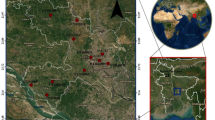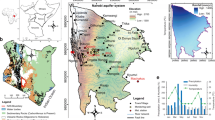Abstract
Large abstraction by water-wells has been causing a linear to exponential drop in groundwater level and substantial aquifer dewatering in Dhaka, Bangladesh. The city is almost entirely dependent on groundwater, which occurs beneath the area in an unconsolidated Plio-Pleistocene sandy aquifer. Analysis shows that the pattern of water-level change largely replicates the patterns of change in the rate of groundwater abstraction. Contribution of the aquifer storage to the abstraction is estimated to be more than 15% in the year 2002. This abstraction has caused a sharp drop in water level throughout the city and turned into two cones of depression in the water level. Upper parts of the aquifer are already dewatered throughout the area, with the exception of part of the northeast and southeast corner of the city. It is calculated that about 41 million cubic metres (MCM) of the aquifer dewatered by the year 1988, which increased to 2,272 MCM in the year 2002. Water-level decline may increase non-linearly due to limiting vertical recharge in areas where the aquifer is dewatered and may severely threaten the sustainability of the aquifer.
Résumé
Des prélèvements massifs dans les puits ont causé des chutes de niveau piézométriques linéaires à exponentielles et un dénoyage substantiel de l’aquifère à Dhaka, au Bangladesh. La ville est presque intégralement dépendante des eaux souterraines, contenues sous ce secteur dans un aquifère de sables non consolidés plio-pléistocènes. Les analyses démontrent que l’allure des variations de niveau reproduit celle générée par des prélèvements en eau souterraine. La contribution des réserves propres de l’aquifère aux prélèvements est estimée à plus de 15% sur l’année 2002. Le prélèvement considéré a occasionné une chute de niveau à l’échelle de la ville, et est marqué par deux cônes de dépression majeurs. Les franges supérieures de l’aquifère sont déjà dénoyées sur le secteur, à l’exception des extrémités nord-est et sud-est de la ville. Selon les calculs, environ 41 millions de mètres cubes (MCM) de l’aquifère ont été dénoyés en 1988, cette quantité augmentant ensuite jusqu’à 2,272 MCM en 2002. La baisse du niveau piézométrique peut s’amplifier de manière non-linéaire sur les secteurs dénoyés, du fait d’une réalimentation limitée, menaçant sérieusement la pérennité de l’aquifère.
Resumen
La extracción fuerte mediante pozos de agua ha causado un descenso lineal a exponencial en el nivel de agua subterránea y un drenaje significativo del acuífero en Dhaka, Bangladesh. La ciudad depende casi completamente de agua subterránea la cual ocurre debajo del área en un acuífero arenoso no consolidado del Plio-Pleistoceno. Los análisis muestran que el patrón de cambio del nivel del agua replica en gran parte los patrones de cambio en la tasa de abstracción de agua subterránea. La contribución del almacenamiento del acuífero a la abstracción se estima en más del 15% en el año 2002. Esta abstracción ha causado un descenso brusco en el nivel del agua en toda la ciudad habiéndose transformado en dos conos de depresión en el nivel del agua. Las partes superiores del acuífero se encuentran drenadas en toda el área, con la excepción de la porción nororiental y la esquina suroriental de la ciudad. Se calcula que aproximadamente 41 millones de metros cúbicos (MMC) del acuífero se habían drenado para el año 1988 lo cual aumentó a 2,272 MMC en el año 2002. El descenso del nivel del agua puede incrementar de modo no lineal debido a recarga vertical limitada en áreas donde el acuífero es drenado y puede amenazar severamente la sostenibilidad del acuífero.











Similar content being viewed by others
References
Ahmed KM, Hasan MK, Burgess WG, Dottridge J, Ravenscroft P, van Wonderen JJ (1999) The Dupi Tila aquifer of Dhaka, Bangladesh: hydraulic and hydrochemical response to intensive exploitation. In: Chilton PJ (ed) Groundwater in the urban environment: selected city profiles. Balkema, Rotterdam, pp 19–30
Ahmed KM, Bhattacharya P, Hasan MA, Akhter SH, Alam SMM, Bhuyian MAH, Imam MB, Khan AA, Sracek O (2004) Arsenic contamination in groundwater of alluvial aquifers in Bangladesh: an overview. Appl Geochem 19:181–200
Alley WM, Reilly TE, Franke OL (1999) Sustainibility of Groundwater Resources. US Geol Surv Circ 1186. US Geological Survey, Denver, CO
BGS/DPHE (Department of Public Health Engineering) (2001) Arsenic contamination of groundwater in Bangladesh. Main report. In: Kinniburgh DG, Smedley PL (ed) British Geol Surv Tech Report WC/00/19. British Geological Survey (BGS), Keyworth, UK
BUET (2000) Updating of existing groundwater and land subsidence project, Final report, Volume 1. Department of Water Resources Engineering and Institute of Flood Control and Drainage Research, Bangladesh University of Engineering and Technology (BUET), Dhaka 1000, Bangladesh
BWDB (Bangladesh Water Development Board) (1991) Effects of overwithdrawal of ground water in Dhaka city. BWDB Water Supply Paper 519, Ground Water Circle-II, BWDB, Dhaka, Bangladesh
Cressie NAC (1990) The Origins of Kriging. Math Geol 22:239–252
Darling WG, Burgess WG, Hasan MK (2002) Isotopic evidence for induced river recharge to the Dupi Tila aquifer in the Dhaka urban area, Bangladesh. In: The application of isotope techniques to the assessment of aquifer systems in major urban areas, TECDOC 1298, IAEA, Vienna, pp 95–107
Davies J (1994) The hydrogeochemistry of alluvial aquifers in central Bangladesh. In: Nash H, McCall GJH (ed) Groundwater Quality. Chapman and Hall, London, UK, pp 9–17
Davies J, Exley C (1992) Short term BGS pilot project to assess the “Hydrochemical character of the main aquifer units of central and north-eastern Bangladesh and possible toxicity of groundwater to fish and human”. Main report. British Geol Surv Tech Report WD/92/44R. British Geological Survey, Keyworth, UK
EPC/MMP (1991) Dhaka region groundwater and subsidence study. Engineering and Planning Consultants (EPC) in association with Sir Mott MacDonald and Partners (MMP). Dhaka Water Supply and Sewerage Authority, Dhaka, Bangladesh
Hasan MK (1999) The vulnerability of the Dupi Tila Aquifer, Dhaka, Bangladesh. PhD Thesis, University College London, UK
Khandoker RA (1987) Origin of elevated Barind-Madhupur areas, Bengal basin results of neotectonic activities. Bangladesh J Geol 6:1–7
Morgan JE, McIntire WC (1959) Quaternary Geology of Bengal Basin, East Pakistan and India. Geol Soc Am Bull 70:319–342
Morris BL, Seddique AA, Ahmed KM (2003) Response of the Dupi Tila aquifer to intensive pumping in Dhaka, Bangladesh. Hydrogeol J 11:496–503
Press WH, Flannery BP, Teukolsky SA, Vetterling WT (1988) Numerical recipes in C: the art of scientific computing. Cambridge University Press, New York
WASA (Water Supply and Sewerage Authority) (2000) Management information report for the month of November 2000. Monthly Bulletin, DWASA, Dhaka, Bangladesh
WASA (Water Supply and Sewerage Authority) (2003) Management Information Report for the month of November 2003. Monthly Bulletin. DWASA, Dhaka, Bangladesh
Acknowledgements
The research reported here represents part of a postgraduate diploma (2004) research work by the first author at the Institute of Water and Flood Management, BUET. The first author is very grateful to Dr. H. A. Michael for her encouraging review, critical comments and suggestions on the manuscript. We also thank Mr. S. Cook for his comments on the manuscript. The authors are very grateful to the anonymous reviewers for their suggestions in improving the quality of the manuscript.
Author information
Authors and Affiliations
Corresponding author
Rights and permissions
About this article
Cite this article
Hoque, M.A., Hoque, M.M. & Ahmed, K.M. Declining groundwater level and aquifer dewatering in Dhaka metropolitan area, Bangladesh: causes and quantification. Hydrogeol J 15, 1523–1534 (2007). https://doi.org/10.1007/s10040-007-0226-5
Received:
Accepted:
Published:
Issue Date:
DOI: https://doi.org/10.1007/s10040-007-0226-5




